David_PPT_Abbrev_Ch02
Slide_chpt02Mechanics

σyy
σxy σyx σxz+dσxz σxz σyz σxy+dσxy σxx+dσxx σzx σ
zy
dz
dx
17
dy σzz
Finite Element Method by G. R. Liu and S. S. Quek
Dynamic equilibrium equations Hence, equilibrium equation in x direction
10
Stress and strain Stresses at a point in a 3D solid:
σ xz = σ zx
σ zy = σ yz σ xy = σ yx
T
σyy σyz σyx
z
σzz σzx σxy σxz σxz σxy σzx σzz σzy σxx σyz σyy σyx
16
Dynamic equilibrium equations Equilibrium of forces in x direction including the inertia forces
(σ xx + dσ xx )dydz − σ xx dydz + (σ yx + dσ yx )dxdz − σ yx dxdz + (σ zx + dσ zx )dxdy − σ zx dxdy + fx
sy.
c11 =
Eν E(1−ν ) , c12 = (1− 2 )(1+ν ) ν (1− 2 )(1+ν ) ν
G= E 2(1+ν )
15
c11 − c12 =G , 2
Finite Element Method by G. R. Liu and S. S. Quek
DAVID-让注释简单起来!
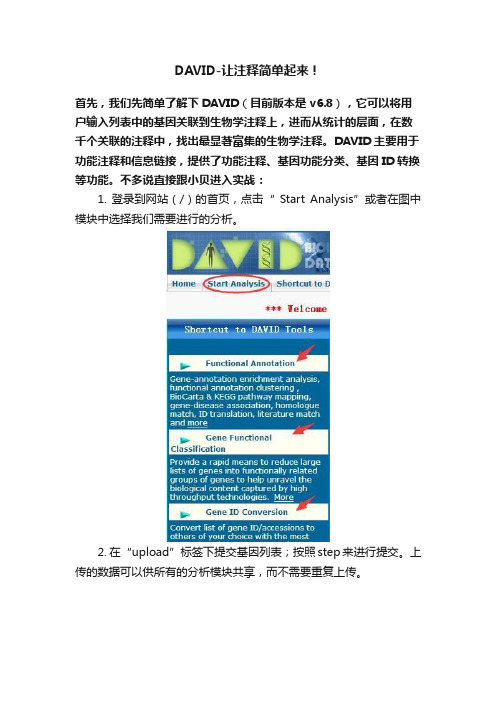
DAVID-让注释简单起来!
首先,我们先简单了解下DAVID(目前版本是 v6.8),它可以将用户输入列表中的基因关联到生物学注释上,进而从统计的层面,在数千个关联的注释中,找出最显著富集的生物学注释。
DAVID主要用于功能注释和信息链接,提供了功能注释、基因功能分类、基因ID转换等功能。
不多说直接跟小贝进入实战:
1. 登录到网站(/)的首页,点击“ Start Analysis”或者在图中模块中选择我们需要进行的分析。
2. 在“upload”标签下提交基因列表;按照step来进行提交。
上传的数据可以供所有的分析模块共享,而不需要重复上传。
3. 上传成功后,界面如下图所示。
点击 use,进入分析。
1) 点击“Functional Annotation T ool”之后,界面如下图所示:
a) Functional Annotation Clustering
b) Functional Annotation Chart
c) Functional Annotation Table
2) 点击“Gene Functional Classification T ool”之后,界面如下图所示:
3) 点击“Gene ID Conversion T ool”之后,界面如下图所示:。
精选教育教学类PPT模板素材 (83)

增补题目这里增补题目这里增补 题目这里增补题目这里增补题目 这里增补题目这里增补题目这里 增补题目这里增补题目这里增补。
增补幻灯片正文题目
增补题目这里增补题目这里增补 题目这里增补题目这里增补题目 这里增补题目这里增补题目这里 增补题目这里增补题目这里增补。
增补幻灯片正文题目
增补题目这里增补题目这里增补 题目这里增补题目这里增补题目 这里增补题目这里增补题目这里 增补题目这里增补题目这里增补。
【第一环节】
文章背景知识
左键这里增补叙述内容,如关键词、部分简单介绍等。 左键这里增补叙述内容,如关键词、部分简单介绍等。
04
左键这里增添文字左键这里增添文字左键这里增添文字 左键这里增添文字左键这里增添文字左键这里增添文字 左键这里增添文字左键这里增添文字左键这里增添文字
左键这里增添文字左键这里增添文字左键这里增添文字 左键这里增添文字左键这里增添文字左键这里增添文字
教育课件PPT模板
猪大叔——给你创意和灵感
目录 DIREpTiR
m
文章背景知识
frite mihr great title here
认字识词朗诵
frite mihr great title here
课文赏析
frite mihr great title here
拓展训练/分组练习
frite mihr great title here
【第三环节】
课文赏析
左键这里增补叙述内容,如关键词、部分简单介绍等。 左键这里增补叙述内容,如关键词、部分简单介绍等。
增补题目
合适内容打在这里,或者通过拷贝 合适叙述后,在此框中选择拷贝, 并选择只保留文字。
增补题目
环保主题PPT模板 (9)

请修改您想要的文本有关汉字请修改您想要的文本有关汉字请修改您想要的文本有关汉字请修改您想要的文本有关汉字请请修改您想要的文本
请修改目录有关汉字
目录有关汉字
此处修改目录
此处修改目录
请修改您想要的文本有关汉字请修改您想要的文本有关汉字请修改您想要的文本有关汉字请修改您想要的文本有关汉字请修改您想要的文本有关汉字请修改您想要的文本有关汉字请修改您想要的文本有关汉字请修改您想要的文本有关汉字请修改您想要的文本有关汉字
目录有关汉字
目录有关汉字
目录有关汉字
箭头单击该位置加入目录
请修改您想要的文本有关汉字请修改您想要的文本有关汉字请修改您想要的文本有关汉字请修改您想要的文本有关汉字请修改您想要的文本有关汉字请修改您想要的文本有关汉字
请在该位置加入您需要的文本有关汉字请在该位置加入您需要的文本有关汉字请在该位置加入您需要的文本有关汉字请在该位置加入您需要的文本有关汉字请在该位置加入您需要的文本有关汉字
目录有关汉字
请在该位置加入您需要的文本有关汉字请在该位置加入您需要的文本有关汉字请在该位置加入您需要的文本有关汉字
请在该位置加入您需要的文本有关汉字请在该位置加入您需要的文本有关汉字请在该位置加入您需要的文本有关汉字
请在该位置加入您需要的文本有关汉字请在该位置加入您需要的文本有关汉字请在该位置加入您需要的文本有关汉字
谢谢聆听
POWERPOINT
thanks
ENVIRONMENTAL
PROTECTION
加入目录有关汉字
请修改您想要的文本有关汉字请修改您想要的文本有关汉字请修改您想要的文本有关汉字请修改您想要的文本有关汉字请修改您想要的文本有关汉字请修改您想要的文本有关汉字请修改您想要的文本有关汉字请修改您想要的文本有关汉字请修改您想要的文本有关汉字
lecture02
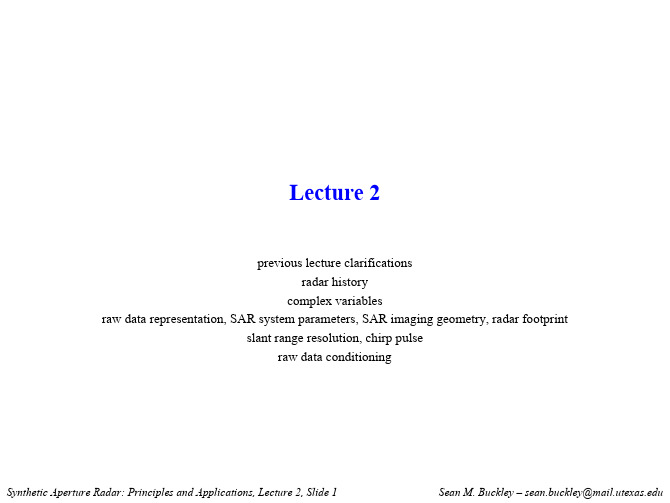
•
remote sensing system
– aircraft, satellite
NASA/JPL SIR-C Education Program NASA/JPL SIR-C Education Program Sean M. Buckley – sean.buckley@
– you may use something other than C or Fortran for homework and projects, e.g., Matlab
•
Polarization
– VV return will be stronger than HH return for vertically-oriented objects [Henderson and Lewis, p. 141]
γ
im aging plane squint angle
•
coherent
C = I + jQ = Ae jψ where A = I 2 + Q 2 and ψ = tan −1 ( Q I )
– mixing gives in-phase & quadrature
•
microwave/radio
pulse 1 sample N s -1 pulse 2 sample N s -1 pulse N p -1 sample N s -1 pulse N p sample N s -1
pulse 1 sample N s pulse 2 sample N s pulse N p -1 sample N s pulse N p sample N s
ACM-GIS%202006-A%20Peer-to-Peer%20Spatial%20Cloaking%20Algorithm%20for%20Anonymous%20Location-based%
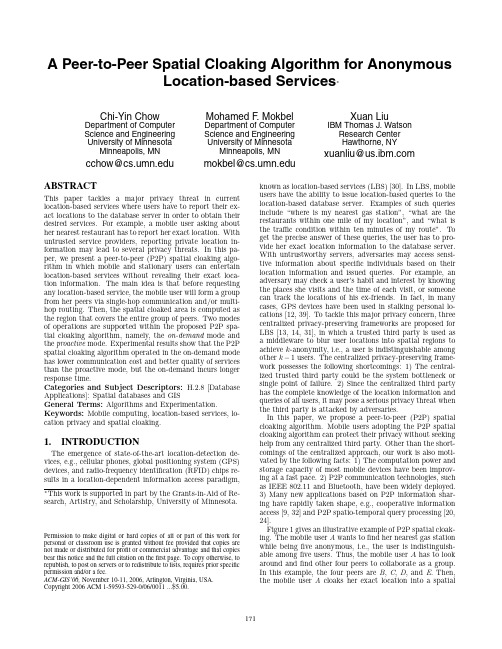
A Peer-to-Peer Spatial Cloaking Algorithm for AnonymousLocation-based Services∗Chi-Yin Chow Department of Computer Science and Engineering University of Minnesota Minneapolis,MN cchow@ Mohamed F.MokbelDepartment of ComputerScience and EngineeringUniversity of MinnesotaMinneapolis,MNmokbel@Xuan LiuIBM Thomas J.WatsonResearch CenterHawthorne,NYxuanliu@ABSTRACTThis paper tackles a major privacy threat in current location-based services where users have to report their ex-act locations to the database server in order to obtain their desired services.For example,a mobile user asking about her nearest restaurant has to report her exact location.With untrusted service providers,reporting private location in-formation may lead to several privacy threats.In this pa-per,we present a peer-to-peer(P2P)spatial cloaking algo-rithm in which mobile and stationary users can entertain location-based services without revealing their exact loca-tion information.The main idea is that before requesting any location-based service,the mobile user will form a group from her peers via single-hop communication and/or multi-hop routing.Then,the spatial cloaked area is computed as the region that covers the entire group of peers.Two modes of operations are supported within the proposed P2P spa-tial cloaking algorithm,namely,the on-demand mode and the proactive mode.Experimental results show that the P2P spatial cloaking algorithm operated in the on-demand mode has lower communication cost and better quality of services than the proactive mode,but the on-demand incurs longer response time.Categories and Subject Descriptors:H.2.8[Database Applications]:Spatial databases and GISGeneral Terms:Algorithms and Experimentation. Keywords:Mobile computing,location-based services,lo-cation privacy and spatial cloaking.1.INTRODUCTIONThe emergence of state-of-the-art location-detection de-vices,e.g.,cellular phones,global positioning system(GPS) devices,and radio-frequency identification(RFID)chips re-sults in a location-dependent information access paradigm,∗This work is supported in part by the Grants-in-Aid of Re-search,Artistry,and Scholarship,University of Minnesota. Permission to make digital or hard copies of all or part of this work for personal or classroom use is granted without fee provided that copies are not made or distributed for profit or commercial advantage and that copies bear this notice and the full citation on thefirst page.To copy otherwise,to republish,to post on servers or to redistribute to lists,requires prior specific permission and/or a fee.ACM-GIS’06,November10-11,2006,Arlington,Virginia,USA. Copyright2006ACM1-59593-529-0/06/0011...$5.00.known as location-based services(LBS)[30].In LBS,mobile users have the ability to issue location-based queries to the location-based database server.Examples of such queries include“where is my nearest gas station”,“what are the restaurants within one mile of my location”,and“what is the traffic condition within ten minutes of my route”.To get the precise answer of these queries,the user has to pro-vide her exact location information to the database server. With untrustworthy servers,adversaries may access sensi-tive information about specific individuals based on their location information and issued queries.For example,an adversary may check a user’s habit and interest by knowing the places she visits and the time of each visit,or someone can track the locations of his ex-friends.In fact,in many cases,GPS devices have been used in stalking personal lo-cations[12,39].To tackle this major privacy concern,three centralized privacy-preserving frameworks are proposed for LBS[13,14,31],in which a trusted third party is used as a middleware to blur user locations into spatial regions to achieve k-anonymity,i.e.,a user is indistinguishable among other k−1users.The centralized privacy-preserving frame-work possesses the following shortcomings:1)The central-ized trusted third party could be the system bottleneck or single point of failure.2)Since the centralized third party has the complete knowledge of the location information and queries of all users,it may pose a serious privacy threat when the third party is attacked by adversaries.In this paper,we propose a peer-to-peer(P2P)spatial cloaking algorithm.Mobile users adopting the P2P spatial cloaking algorithm can protect their privacy without seeking help from any centralized third party.Other than the short-comings of the centralized approach,our work is also moti-vated by the following facts:1)The computation power and storage capacity of most mobile devices have been improv-ing at a fast pace.2)P2P communication technologies,such as IEEE802.11and Bluetooth,have been widely deployed.3)Many new applications based on P2P information shar-ing have rapidly taken shape,e.g.,cooperative information access[9,32]and P2P spatio-temporal query processing[20, 24].Figure1gives an illustrative example of P2P spatial cloak-ing.The mobile user A wants tofind her nearest gas station while beingfive anonymous,i.e.,the user is indistinguish-able amongfive users.Thus,the mobile user A has to look around andfind other four peers to collaborate as a group. In this example,the four peers are B,C,D,and E.Then, the mobile user A cloaks her exact location into a spatialA B CDEBase Stationregion that covers the entire group of mobile users A ,B ,C ,D ,and E .The mobile user A randomly selects one of the mobile users within the group as an agent .In the ex-ample given in Figure 1,the mobile user D is selected as an agent.Then,the mobile user A sends her query (i.e.,what is the nearest gas station)along with her cloaked spa-tial region to the agent.The agent forwards the query to the location-based database server through a base station.Since the location-based database server processes the query based on the cloaked spatial region,it can only give a list of candidate answers that includes the actual answers and some false positives.After the agent receives the candidate answers,it forwards the candidate answers to the mobile user A .Finally,the mobile user A gets the actual answer by filtering out all the false positives.The proposed P2P spatial cloaking algorithm can operate in two modes:on-demand and proactive .In the on-demand mode,mobile clients execute the cloaking algorithm when they need to access information from the location-based database server.On the other side,in the proactive mode,mobile clients periodically look around to find the desired number of peers.Thus,they can cloak their exact locations into spatial regions whenever they want to retrieve informa-tion from the location-based database server.In general,the contributions of this paper can be summarized as follows:1.We introduce a distributed system architecture for pro-viding anonymous location-based services (LBS)for mobile users.2.We propose the first P2P spatial cloaking algorithm for mobile users to entertain high quality location-based services without compromising their privacy.3.We provide experimental evidence that our proposed algorithm is efficient in terms of the response time,is scalable to large numbers of mobile clients,and is effective as it provides high-quality services for mobile clients without the need of exact location information.The rest of this paper is organized as follows.Section 2highlights the related work.The system model of the P2P spatial cloaking algorithm is presented in Section 3.The P2P spatial cloaking algorithm is described in Section 4.Section 5discusses the integration of the P2P spatial cloak-ing algorithm with privacy-aware location-based database servers.Section 6depicts the experimental evaluation of the P2P spatial cloaking algorithm.Finally,Section 7con-cludes this paper.2.RELATED WORKThe k -anonymity model [37,38]has been widely used in maintaining privacy in databases [5,26,27,28].The main idea is to have each tuple in the table as k -anonymous,i.e.,indistinguishable among other k −1tuples.Although we aim for the similar k -anonymity model for the P2P spatial cloaking algorithm,none of these techniques can be applied to protect user privacy for LBS,mainly for the following four reasons:1)These techniques preserve the privacy of the stored data.In our model,we aim not to store the data at all.Instead,we store perturbed versions of the data.Thus,data privacy is managed before storing the data.2)These approaches protect the data not the queries.In anonymous LBS,we aim to protect the user who issues the query to the location-based database server.For example,a mobile user who wants to ask about her nearest gas station needs to pro-tect her location while the location information of the gas station is not protected.3)These approaches guarantee the k -anonymity for a snapshot of the database.In LBS,the user location is continuously changing.Such dynamic be-havior calls for continuous maintenance of the k -anonymity model.(4)These approaches assume a unified k -anonymity requirement for all the stored records.In our P2P spatial cloaking algorithm,k -anonymity is a user-specified privacy requirement which may have a different value for each user.Motivated by the privacy threats of location-detection de-vices [1,4,6,40],several research efforts are dedicated to protect the locations of mobile users (e.g.,false dummies [23],landmark objects [18],and location perturbation [10,13,14]).The most closed approaches to ours are two centralized spatial cloaking algorithms,namely,the spatio-temporal cloaking [14]and the CliqueCloak algorithm [13],and one decentralized privacy-preserving algorithm [23].The spatio-temporal cloaking algorithm [14]assumes that all users have the same k -anonymity requirements.Furthermore,it lacks the scalability because it deals with each single request of each user individually.The CliqueCloak algorithm [13]as-sumes a different k -anonymity requirement for each user.However,since it has large computation overhead,it is lim-ited to a small k -anonymity requirement,i.e.,k is from 5to 10.A decentralized privacy-preserving algorithm is proposed for LBS [23].The main idea is that the mobile client sends a set of false locations,called dummies ,along with its true location to the location-based database server.However,the disadvantages of using dummies are threefold.First,the user has to generate realistic dummies to pre-vent the adversary from guessing its true location.Second,the location-based database server wastes a lot of resources to process the dummies.Finally,the adversary may esti-mate the user location by using cellular positioning tech-niques [34],e.g.,the time-of-arrival (TOA),the time differ-ence of arrival (TDOA)and the direction of arrival (DOA).Although several existing distributed group formation al-gorithms can be used to find peers in a mobile environment,they are not designed for privacy preserving in LBS.Some algorithms are limited to only finding the neighboring peers,e.g.,lowest-ID [11],largest-connectivity (degree)[33]and mobility-based clustering algorithms [2,25].When a mo-bile user with a strict privacy requirement,i.e.,the value of k −1is larger than the number of neighboring peers,it has to enlist other peers for help via multi-hop routing.Other algorithms do not have this limitation,but they are designed for grouping stable mobile clients together to facil-Location-based Database ServerDatabase ServerDatabase ServerFigure 2:The system architectureitate efficient data replica allocation,e.g.,dynamic connec-tivity based group algorithm [16]and mobility-based clus-tering algorithm,called DRAM [19].Our work is different from these approaches in that we propose a P2P spatial cloaking algorithm that is dedicated for mobile users to dis-cover other k −1peers via single-hop communication and/or via multi-hop routing,in order to preserve user privacy in LBS.3.SYSTEM MODELFigure 2depicts the system architecture for the pro-posed P2P spatial cloaking algorithm which contains two main components:mobile clients and location-based data-base server .Each mobile client has its own privacy profile that specifies its desired level of privacy.A privacy profile includes two parameters,k and A min ,k indicates that the user wants to be k -anonymous,i.e.,indistinguishable among k users,while A min specifies the minimum resolution of the cloaked spatial region.The larger the value of k and A min ,the more strict privacy requirements a user needs.Mobile users have the ability to change their privacy profile at any time.Our employed privacy profile matches the privacy re-quirements of mobiles users as depicted by several social science studies (e.g.,see [4,15,17,22,29]).In this architecture,each mobile user is equipped with two wireless network interface cards;one of them is dedicated to communicate with the location-based database server through the base station,while the other one is devoted to the communication with other peers.A similar multi-interface technique has been used to implement IP multi-homing for stream control transmission protocol (SCTP),in which a machine is installed with multiple network in-terface cards,and each assigned a different IP address [36].Similarly,in mobile P2P cooperation environment,mobile users have a network connection to access information from the server,e.g.,through a wireless modem or a base station,and the mobile users also have the ability to communicate with other peers via a wireless LAN,e.g.,IEEE 802.11or Bluetooth [9,24,32].Furthermore,each mobile client is equipped with a positioning device, e.g.,GPS or sensor-based local positioning systems,to determine its current lo-cation information.4.P2P SPATIAL CLOAKINGIn this section,we present the data structure and the P2P spatial cloaking algorithm.Then,we describe two operation modes of the algorithm:on-demand and proactive .4.1Data StructureThe entire system area is divided into grid.The mobile client communicates with each other to discover other k −1peers,in order to achieve the k -anonymity requirement.TheAlgorithm 1P2P Spatial Cloaking:Request Originator m 1:Function P2PCloaking-Originator (h ,k )2://Phase 1:Peer searching phase 3:The hop distance h is set to h4:The set of discovered peers T is set to {∅},and the number ofdiscovered peers k =|T |=05:while k <k −1do6:Broadcast a FORM GROUP request with the parameter h (Al-gorithm 2gives the response of each peer p that receives this request)7:T is the set of peers that respond back to m by executingAlgorithm 28:k =|T |;9:if k <k −1then 10:if T =T then 11:Suspend the request 12:end if 13:h ←h +1;14:T ←T ;15:end if 16:end while17://Phase 2:Location adjustment phase 18:for all T i ∈T do19:|mT i .p |←the greatest possible distance between m and T i .pby considering the timestamp of T i .p ’s reply and maximum speed20:end for21://Phase 3:Spatial cloaking phase22:Form a group with k −1peers having the smallest |mp |23:h ←the largest hop distance h p of the selected k −1peers 24:Determine a grid area A that covers the entire group 25:if A <A min then26:Extend the area of A till it covers A min 27:end if28:Randomly select a mobile client of the group as an agent 29:Forward the query and A to the agentmobile client can thus blur its exact location into a cloaked spatial region that is the minimum grid area covering the k −1peers and itself,and satisfies A min as well.The grid area is represented by the ID of the left-bottom and right-top cells,i.e.,(l,b )and (r,t ).In addition,each mobile client maintains a parameter h that is the required hop distance of the last peer searching.The initial value of h is equal to one.4.2AlgorithmFigure 3gives a running example for the P2P spatial cloaking algorithm.There are 15mobile clients,m 1to m 15,represented as solid circles.m 8is the request originator,other black circles represent the mobile clients received the request from m 8.The dotted circles represent the commu-nication range of the mobile client,and the arrow represents the movement direction.Algorithms 1and 2give the pseudo code for the request originator (denoted as m )and the re-quest receivers (denoted as p ),respectively.In general,the algorithm consists of the following three phases:Phase 1:Peer searching phase .The request origina-tor m wants to retrieve information from the location-based database server.m first sets h to h ,a set of discovered peers T to {∅}and the number of discovered peers k to zero,i.e.,|T |.(Lines 3to 4in Algorithm 1).Then,m broadcasts a FORM GROUP request along with a message sequence ID and the hop distance h to its neighboring peers (Line 6in Algorithm 1).m listens to the network and waits for the reply from its neighboring peers.Algorithm 2describes how a peer p responds to the FORM GROUP request along with a hop distance h and aFigure3:P2P spatial cloaking algorithm.Algorithm2P2P Spatial Cloaking:Request Receiver p1:Function P2PCloaking-Receiver(h)2://Let r be the request forwarder3:if the request is duplicate then4:Reply r with an ACK message5:return;6:end if7:h p←1;8:if h=1then9:Send the tuple T=<p,(x p,y p),v maxp ,t p,h p>to r10:else11:h←h−1;12:Broadcast a FORM GROUP request with the parameter h 13:T p is the set of peers that respond back to p14:for all T i∈T p do15:T i.h p←T i.h p+1;16:end for17:T p←T p∪{<p,(x p,y p),v maxp ,t p,h p>};18:Send T p back to r19:end ifmessage sequence ID from another peer(denoted as r)that is either the request originator or the forwarder of the re-quest.First,p checks if it is a duplicate request based on the message sequence ID.If it is a duplicate request,it sim-ply replies r with an ACK message without processing the request.Otherwise,p processes the request based on the value of h:Case1:h= 1.p turns in a tuple that contains its ID,current location,maximum movement speed,a timestamp and a hop distance(it is set to one),i.e.,< p,(x p,y p),v max p,t p,h p>,to r(Line9in Algorithm2). Case2:h> 1.p decrements h and broadcasts the FORM GROUP request with the updated h and the origi-nal message sequence ID to its neighboring peers.p keeps listening to the network,until it collects the replies from all its neighboring peers.After that,p increments the h p of each collected tuple,and then it appends its own tuple to the collected tuples T p.Finally,it sends T p back to r (Lines11to18in Algorithm2).After m collects the tuples T from its neighboring peers, if m cannotfind other k−1peers with a hop distance of h,it increments h and re-broadcasts the FORM GROUP request along with a new message sequence ID and h.m repeatedly increments h till itfinds other k−1peers(Lines6to14in Algorithm1).However,if mfinds the same set of peers in two consecutive broadcasts,i.e.,with hop distances h and h+1,there are not enough connected peers for m.Thus, m has to relax its privacy profile,i.e.,use a smaller value of k,or to be suspended for a period of time(Line11in Algorithm1).Figures3(a)and3(b)depict single-hop and multi-hop peer searching in our running example,respectively.In Fig-ure3(a),the request originator,m8,(e.g.,k=5)canfind k−1peers via single-hop communication,so m8sets h=1. Since h=1,its neighboring peers,m5,m6,m7,m9,m10, and m11,will not further broadcast the FORM GROUP re-quest.On the other hand,in Figure3(b),m8does not connect to k−1peers directly,so it has to set h>1.Thus, its neighboring peers,m7,m10,and m11,will broadcast the FORM GROUP request along with a decremented hop dis-tance,i.e.,h=h−1,and the original message sequence ID to their neighboring peers.Phase2:Location adjustment phase.Since the peer keeps moving,we have to capture the movement between the time when the peer sends its tuple and the current time. For each received tuple from a peer p,the request originator, m,determines the greatest possible distance between them by an equation,|mp |=|mp|+(t c−t p)×v max p,where |mp|is the Euclidean distance between m and p at time t p,i.e.,|mp|=(x m−x p)2+(y m−y p)2,t c is the currenttime,t p is the timestamp of the tuple and v maxpis the maximum speed of p(Lines18to20in Algorithm1).In this paper,a conservative approach is used to determine the distance,because we assume that the peer will move with the maximum speed in any direction.If p gives its movement direction,m has the ability to determine a more precise distance between them.Figure3(c)illustrates that,for each discovered peer,the circle represents the largest region where the peer can lo-cate at time t c.The greatest possible distance between the request originator m8and its discovered peer,m5,m6,m7, m9,m10,or m11is represented by a dotted line.For exam-ple,the distance of the line m8m 11is the greatest possible distance between m8and m11at time t c,i.e.,|m8m 11|. Phase3:Spatial cloaking phase.In this phase,the request originator,m,forms a virtual group with the k−1 nearest peers,based on the greatest possible distance be-tween them(Line22in Algorithm1).To adapt to the dynamic network topology and k-anonymity requirement, m sets h to the largest value of h p of the selected k−1 peers(Line15in Algorithm1).Then,m determines the minimum grid area A covering the entire group(Line24in Algorithm1).If the area of A is less than A min,m extends A,until it satisfies A min(Lines25to27in Algorithm1). Figure3(c)gives the k−1nearest peers,m6,m7,m10,and m11to the request originator,m8.For example,the privacy profile of m8is(k=5,A min=20cells),and the required cloaked spatial region of m8is represented by a bold rectan-gle,as depicted in Figure3(d).To issue the query to the location-based database server anonymously,m randomly selects a mobile client in the group as an agent(Line28in Algorithm1).Then,m sendsthe query along with the cloaked spatial region,i.e.,A,to the agent(Line29in Algorithm1).The agent forwards thequery to the location-based database server.After the serverprocesses the query with respect to the cloaked spatial re-gion,it sends a list of candidate answers back to the agent.The agent forwards the candidate answer to m,and then mfilters out the false positives from the candidate answers. 4.3Modes of OperationsThe P2P spatial cloaking algorithm can operate in twomodes,on-demand and proactive.The on-demand mode:The mobile client only executesthe algorithm when it needs to retrieve information from the location-based database server.The algorithm operatedin the on-demand mode generally incurs less communica-tion overhead than the proactive mode,because the mobileclient only executes the algorithm when necessary.However,it suffers from a longer response time than the algorithm op-erated in the proactive mode.The proactive mode:The mobile client adopting theproactive mode periodically executes the algorithm in back-ground.The mobile client can cloak its location into a spa-tial region immediately,once it wants to communicate withthe location-based database server.The proactive mode pro-vides a better response time than the on-demand mode,but it generally incurs higher communication overhead and giveslower quality of service than the on-demand mode.5.ANONYMOUS LOCATION-BASEDSERVICESHaving the spatial cloaked region as an output form Algo-rithm1,the mobile user m sends her request to the location-based server through an agent p that is randomly selected.Existing location-based database servers can support onlyexact point locations rather than cloaked regions.In or-der to be able to work with a spatial region,location-basedservers need to be equipped with a privacy-aware queryprocessor(e.g.,see[29,31]).The main idea of the privacy-aware query processor is to return a list of candidate answerrather than the exact query answer.Then,the mobile user m willfilter the candidate list to eliminate its false positives andfind its exact answer.The tighter the spatial cloaked re-gion,the lower is the size of the candidate answer,and hencethe better is the performance of the privacy-aware query processor.However,tight cloaked regions may represent re-laxed privacy constrained.Thus,a trade-offbetween the user privacy and the quality of service can be achieved[31]. Figure4(a)depicts such scenario by showing the data stored at the server side.There are32target objects,i.e., gas stations,T1to T32represented as black circles,the shaded area represents the spatial cloaked area of the mo-bile client who issued the query.For clarification,the actual mobile client location is plotted in Figure4(a)as a black square inside the cloaked area.However,such information is neither stored at the server side nor revealed to the server. The privacy-aware query processor determines a range that includes all target objects that are possibly contributing to the answer given that the actual location of the mobile client could be anywhere within the shaded area.The range is rep-resented as a bold rectangle,as depicted in Figure4(b).The server sends a list of candidate answers,i.e.,T8,T12,T13, T16,T17,T21,and T22,back to the agent.The agent next for-(a)Server Side(b)Client SideFigure4:Anonymous location-based services wards the candidate answers to the requesting mobile client either through single-hop communication or through multi-hop routing.Finally,the mobile client can get the actualanswer,i.e.,T13,byfiltering out the false positives from thecandidate answers.The algorithmic details of the privacy-aware query proces-sor is beyond the scope of this paper.Interested readers are referred to[31]for more details.6.EXPERIMENTAL RESULTSIn this section,we evaluate and compare the scalabilityand efficiency of the P2P spatial cloaking algorithm in boththe on-demand and proactive modes with respect to the av-erage response time per query,the average number of mes-sages per query,and the size of the returned candidate an-swers from the location-based database server.The queryresponse time in the on-demand mode is defined as the timeelapsed between a mobile client starting to search k−1peersand receiving the candidate answers from the agent.On theother hand,the query response time in the proactive mode is defined as the time elapsed between a mobile client startingto forward its query along with the cloaked spatial regionto the agent and receiving the candidate answers from theagent.The simulation model is implemented in C++usingCSIM[35].In all the experiments in this section,we consider an in-dividual random walk model that is based on“random way-point”model[7,8].At the beginning,the mobile clientsare randomly distributed in a spatial space of1,000×1,000square meters,in which a uniform grid structure of100×100cells is constructed.Each mobile client randomly chooses itsown destination in the space with a randomly determined speed s from a uniform distribution U(v min,v max).When the mobile client reaches the destination,it comes to a stand-still for one second to determine its next destination.Afterthat,the mobile client moves towards its new destinationwith another speed.All the mobile clients repeat this move-ment behavior during the simulation.The time interval be-tween two consecutive queries generated by a mobile client follows an exponential distribution with a mean of ten sec-onds.All the experiments consider one half-duplex wirelesschannel for a mobile client to communicate with its peers with a total bandwidth of2Mbps and a transmission range of250meters.When a mobile client wants to communicate with other peers or the location-based database server,it has to wait if the requested channel is busy.In the simulated mobile environment,there is a centralized location-based database server,and one wireless communication channel between the location-based database server and the mobile。
蛋白质GeneontologyKEGG分析软件David使用方法介绍专题培训课件
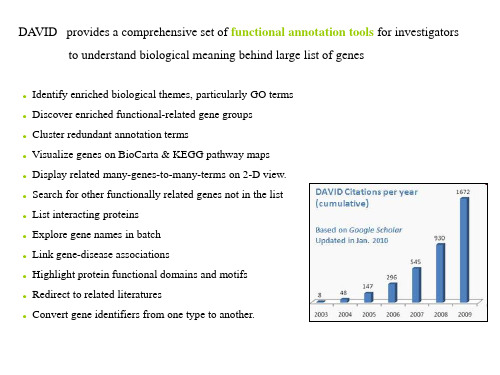
DAVID Gene Name Batch Viewer
1. The gene name batch viewer is able to quickly attach meaning to a list of gene IDs by rapidly translating them into their corresponding gene names.
Similarity Threshold (any value between 0 to 1; Default = 0.35): the minimum kappa value to be considered biological significant.
Initial Group Members (any value >=2; default = 4): the minimum gene number in a seeding group, which affects the minimum size of each functional group in the final.
Linear or redundant chart report of annotation terms for all selected annotation categories above
Clustered or non-redundant chart report of annotation terms for all selected annotation categories above
2. before proceeding to analysis with other more comprehensive analytic tools, investigators can quickly glance at the gene names to further gain insight about their study and to answer questions.
51ppt_075

Company name
Slide master
• Your Text here • Lorem ipsum dolor sit amet, consectetuer adipiscing elit, sed diam
nonummy nibh euismod tincidunt ut laoreet dolore magna aliquam erat volutpat. Ut wisi enim ad minim veniam, quis nostrud exerci tation ullamcorper suscipit lobortis nisl ut aliquip ex ea commodo consequat. • Duis autem vel eum iriure dolor in hendrerit in vulputate velit esse molestie consequat, vel illum dolore eu feugiat nulla facilisis at vero eros et accumsan et iusto odio dignissim qui blandit praesent luptatum zzril delenit augue duis dolore te feugait nulla facilisi. • Lorem ipsum dolor sit amet, consectetuer adipiscing elit, sed diam nonummy nibh euismod tincidunt ut laoreet dolore magna aliquam erat volutpat. Ut wisi enim ad minim veniam, quis nostrud exerci tation ullamcorper suscipit lobortis nisl ut aliquip ex ea commodo coxt here • Lorem ipsum dolor sit amet, consectetuer
DAVID使用方法介绍
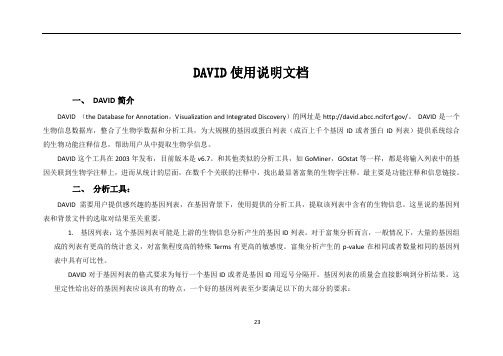
DAVID使用说明文档一、DAVID简介DAVID (the Database for Annotation,Visualization and Integrated Discovery)的网址是/。
DAVID是一个生物信息数据库,整合了生物学数据和分析工具,为大规模的基因或蛋白列表(成百上千个基因ID或者蛋白ID列表)提供系统综合的生物功能注释信息,帮助用户从中提取生物学信息。
DAVID这个工具在2003年发布,目前版本是v6.7。
和其他类似的分析工具,如GoMiner,GOstat等一样,都是将输入列表中的基因关联到生物学注释上,进而从统计的层面,在数千个关联的注释中,找出最显著富集的生物学注释。
最主要是功能注释和信息链接。
二、分析工具:DAVID需要用户提供感兴趣的基因列表,在基因背景下,使用提供的分析工具,提取该列表中含有的生物信息。
这里说的基因列表和背景文件的选取对结果至关重要。
1.基因列表:这个基因列表可能是上游的生物信息分析产生的基因ID列表。
对于富集分析而言,一般情况下,大量的基因组成的列表有更高的统计意义,对富集程度高的特殊Terms有更高的敏感度。
富集分析产生的p-value在相同或者数量相同的基因列表中具有可比性。
DAVID对于基因列表的格式要求为每行一个基因ID或者是基因ID用逗号分隔开。
基因列表的质量会直接影响到分析结果。
这里定性给出好的基因列表应该具有的特点,一个好的基因列表至少要满足以下的大部分的要求:23(1)包含与研究目的相关的大部分重要的基因(如标识基因)。
(2)基因的数量不能太多或者太少,一般是100至10000这个数量级。
(3)大部分基因可以较好的通过统计筛选,例如,在控制组和对照组样品间选择显著差异表达基因时,使用的t-test 标准:fold changes >=2 && P-values <=0.05。
(4)大部分是上下调的基因都涉及到特定的某一生物过程,而不是随机的散布到所有可能的生物过程中。
DAVID-v6.7学习资料

• 数据上传
• =>选择Functional Annotation(菜单栏 Short cut里或传完后 直接选择)
• =>分析结果概览 (Summary results)
• =>Clustering, Chart 或Table
• =>结果保存
1.提交的信息
结果概览
点击
• Kappa值越高相似度越高
• Thanks
此课件下载可自行编辑修改,仅供参考! 感谢您的支持,我们努力做得更好!谢谢
该基因所在的terms
物种
基因功能分类
• 按照基因的生物学功能,相似的归为一类
• 数据导入 • =>运算 • =>TEXT结果格式 • =>图像结果格式
分成了多少个cluster 限定强度
该cluster涉及到的terms
画图
相关基因
该cluster里的基因
注释
Gene batch viewer:快速查找相似基因
相关term
在生物学上 比较类似的 一组term
EASE 分值,也就是修正后的P值(越低越显著) FDR可选
数据信息
规定term的最少基因数 规定p值
Chart
每页至多rm搜索
基因数
P值 FDR
百分比
Table:以逐条的基因为中心
基因ID
相关基因
Database
先用conversiontool转换再提交列表信息及编辑选定重命名删除组合及显示基因列表background一般系统会自动选好如果没选好可以去david自带的background里查找设置或自行上传列表可循环利用于后面的所有分析无需重复上传id概述是否找到按照id来源的概述点击图标集体转换每个id的详细列表点击图标单独转换选择functionalannotation菜单栏short分析结果概览summaryresultsclusteringchart或tablefunctionalcategoriesgeneralannotationsmainaccessionsproteindomainsproteininteractionstissueexpression1
毕业论文答辩PPT模版

关键词
关键词
关键词
添加您的标题
点击输入文本信息点击输入文本信息点击输入文本信息点击 输入文本信息点击输入文本信息点击输入文本信息点击输入
Please add the text here Please add the text here Please add the text here Please add the text here Please add the text here Please add the text here
PART 03
研究方法与过程
添加您的标题
关键词 关键词 关键词 关键词 关键词
添加您的标题
点击输入文本信息点击输 入文本信息点击输入文本
添加您的标题
点击输入文本信息点击输 入文本信息点击输入文本
添加您的标题
点击输入文本信息点击输 入文本信息点击输入文本
添加您的标题
添加标题
Text here
添加标题
答辩人:苏小二
指导老师rever you go, no matter what the weather, always bring your own sunshine.
答辩人:苏小二
指导老师:苏小二
目录
01. 选题背景和意义 02. 研究内容与思路 03. 研究方法与过程 04. 研究成果与展示
PART 01
选题背景和意义
添加您的标题
选题背景和意义 选题背景和意义
添加标题
Please add the text here Please add the text here Please add the text here Please add the text here Please add the text here Please add the text here
- 1、下载文档前请自行甄别文档内容的完整性,平台不提供额外的编辑、内容补充、找答案等附加服务。
- 2、"仅部分预览"的文档,不可在线预览部分如存在完整性等问题,可反馈申请退款(可完整预览的文档不适用该条件!)。
- 3、如文档侵犯您的权益,请联系客服反馈,我们会尽快为您处理(人工客服工作时间:9:00-18:30)。
To be the first choice in the printed communications business. The first choice is the best choice, and being the best is what Atlanta Web pledges to work hard at being—every day!
Public Image
Copyright 2007 Prentice Hall
Ch 2 -12
Ben & Jerry’s Mission
Ben & Jerry’s mission is to make, distribute and sell the finest quality all-natural ice cream and related products in a wide variety of innovative flavors made from Vermont dairy products. To operate the Company on a sound financial basis of profitable growth, increasing value for our shareholders, and creating career opportunities and financial rewards for our employees. To operate the Company in a way that actively recognizes the central role that business plays in the structure of society by initiating innovative ways to improve the quality of life of a broad community—local, national and international.
Copyright 2007 Prentice Hall
Ch 2 -10
Vision & Mission
Research results are mixed, however, firms with formal mission statemenurn on shareholder’s equity • Positive relationship to company performance • 30% higher return on certain financial measures
-- Atlanta Web Printers, Inc.
Copyright 2007 Prentice Hall
Ch 2 -3
Mission Statement
“What is our business?”
Copyright 2007 Prentice Hall
Ch 2 -4
Mission Statements
•Enduring statement of purpose
•Distinguishes one firm from another •Declares the firm’s reason for being
Copyright 2007 Prentice Hall
Ch 2 -5
Vision & Mission
Copyright 2007 Prentice Hall
Ch 2 -11
Customers
Products Services
Markets
Technology Employees
Mission Elements
Survival Growth Profit Self-Concept Philosophy
-- The Bellevue Hospital
Copyright 2007 Prentice Hall
Ch 2 -7
Importance of Mission
Benefits from a strong mission
Unanimity of Purpose
Resource Allocation
Mission
Organizational Climate Focal point for work structure
Copyright 2007 Prentice Hall
Ch 2 -8
Mission & Customer Orientation – Vern McGinnis
• Define what the organization is • Define what it aspires to be • Limited to exclude some ventures • Broad enough to allow for growth • Distinguishes firm from all others • Stated clearly – understood by all
Profit & vision are necessary to effectively motivate a workforce
Copyright 2007 Prentice Hall
Ch 2 -6
Mission Statement Examples
The Bellevue Hospital, with respect, compassion, integrity, and courage, honors the individuality and confidentiality of our patients, employees, and community, and is progressive in anticipating and providing future health care services.
Shared Vision -• Creates commonality of interests • Reduce daily monotony • Provides opportunity & challenge
Copyright 2007 Prentice Hall
Ch 2 -2
Vision Statement Examples
Chapter 2 The Business Vision & Mission
Strategic Management: Concepts & Cases 11th Edition Fred David
Copyright 2007 Prentice Hall
Ch 2 -1
Vision & Mission
Copyright 2007 Prentice Hall
Ch 2 -9
Social Policy & Mission
Social policy should be integrated in all strategic-management activities Mission should convey the social responsibility of the firm
